Rory Gallagher
| Rory Gallagher | |
|---|---|
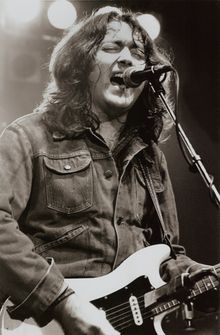 Gallagher, playing at the Manchester Apollo in 1982 Photo: Harry Potts |
|
| Background information | |
| Birth name | William Rory Gallagher |
| Also known as | Liam Rory Gallagher |
| Born | 2 March 1948, Ballyshannon, County Donegal, Ireland |
| Died | 14 June 1995 (aged 47), London, England, United Kingdom |
| Genres | Blues, blues-rock, hard rock, rhythm and blues, rock and roll, jazz, folk, skiffle |
| Occupations | Musician, Songwriter, Bandleader, producer |
| Instruments | Vocals, guitar, bass, mandolin, saxophone, sitar, harmonica, banjo, dobro |
| Years active | 1963–1995 |
| Labels | Polydor, Chrysalis, Buddah Records, Castle Records |
| Associated acts | Taste |
| Website | rorygallagher.com |
| Notable instruments | |
| Fender Stratocaster | |
Rory Gallagher born William Rory Gallagher (2 March 1948 – 14 June 1995)[1][2] (![]() /ˈrɔriː ˈɡæləhər/ (GAL-ə-hər)) was an Irish blues-rock multi-instrumentalist, songwriter, and bandleader. Born in Ballyshannon, County Donegal, Ireland,[3] and raised in Cork, Gallagher recorded solo albums throughout 1970s and 1980s, after forming the band Taste during the late 1960s. A talented guitarist known for his charismatic performances and dedication to his craft, Gallagher's albums have sold in excess of 30 million copies worldwide.[4][5] Gallagher received a liver transplant in 1995, but died of complications later that year in London, England aged 47.[6]
/ˈrɔriː ˈɡæləhər/ (GAL-ə-hər)) was an Irish blues-rock multi-instrumentalist, songwriter, and bandleader. Born in Ballyshannon, County Donegal, Ireland,[3] and raised in Cork, Gallagher recorded solo albums throughout 1970s and 1980s, after forming the band Taste during the late 1960s. A talented guitarist known for his charismatic performances and dedication to his craft, Gallagher's albums have sold in excess of 30 million copies worldwide.[4][5] Gallagher received a liver transplant in 1995, but died of complications later that year in London, England aged 47.[6]
Contents |
Biography
Although Gallagher was born in Ballyshannon, his family moved, first to Derry City where his younger brother Dónal was born in 1949, and then to Cork, where the two brothers were raised. Their father Daniel played the accordion and sang with the Tir Chonaill Ceile Band in Donegal, and their mother Monica was a singer and acted with the Abbey Players in Ballyshannon. The Theatre in Ballyshannon where Monica once acted is now called the Rory Gallagher Theatre. Both sons were musically inclined and encouraged by their parents. At age nine, Gallagher received his first guitar from them, and began to teach himself to play, performing at first at minor functions. After winning a talent contest when he was twelve, Gallagher began performing in his adolescence with both his acoustic guitar, and an electric guitar he bought with his prize money. However, it was his purchase three years later, of a 1961 Fender Stratocaster for £100 that became his primary instrument most associated with him for the span of his lifetime.[7] Initially playing skiffle, after hearing Lonnie Donegan on the radio, who frequently covered blues and folk performers from the United States, Gallagher began experimenting with folk, blues, and rock music. Unable to find or afford record albums, Gallagher stayed up late to hear Radio Luxembourg and AFN where the radio brought him his only exposure to the actual songwriters and musicians whose music moved him most.[8] Influences he discovered, and cited as he progressed, that included Woody Guthrie, Big Bill Broonzy, and Lead Belly. Initially, Gallagher struck out after just an acoustic sound.[7] Singing and later using a brace for his harmonica, Gallagher learned to play slide guitar, using a plectrum and metal slide on his smallest finger. Several years later he also became proficient on the alto saxophone, bass, mandolin, banjo, and the coral sitar, utilizing a glass slide made from an American Coricidian bottle, on his electric guitars (as did many contemporaries, such as Duane Allman), instead of the metal slide.[9] Gallagher stated that his ability to track down the actual original songwriters and performers of blues numbers which he had first heard performed by others like Lonnie Donegan took time and dedication, and had not been easy. Having no role models in Cork, Ireland, he continued to rely entirely on radio programs and television. Occasionally, the jazz programs from the BBC would play some blues numbers, and he was able to slowly find songbooks for guitar, where he found the names of the actual composers of blues pieces. While still in school, playing songs by Buddy Holly and Eddie Cochran, he discovered his greatest influence in Muddy Waters. By his mid-teens, he began experimenting heavily with different blues styles.[10]
Gallagher began playing after school with Irish showbands, while still a young teenager. In 1963,[11] he joined one named Fontana, a sextet playing the popular hit songs of the day. The band toured Ireland and the United Kingdom, giving him the opportunity to acquire songbooks for the guitar, where he found the names of the actual composers of blues songs, in addition to earning the money for the payments that were due on his Stratocaster guitar. Gallagher began to influence the band's repertoire, beginning its transition from popular music, skirting along some of Chuck Berry's songs and by 1965, he had successfully molded Fontana into "The Impact", with a change in their lineup into an R&B group which played gigs in Ireland and Spain, finally disbanding in London.[9] Gallagher left with the bassist and drummer to perform as a trio in Hamburg, Germany.[11] In 1966, Gallagher returned to Ireland and, experimenting with other musicians back home in Cork, decided to form his own band.
Taste
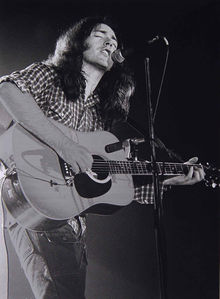
Having completed a musical apprenticeship in the showbands, and influenced by the increasing popularity of beat groups during the early 1960s, Gallagher formed "The Taste", which was later renamed simply, "Taste", a blues and R&B trio, in 1966.[12] Initially, the band was composed of Gallagher and two Cork musicians, Norman Damery and Eric Kitteringham, however, by 1968, they were replaced with two musicians from Belfast, featuring Gallagher on guitar and vocals, drummer John Wilson, and bassist Richard McCracken.[12] Performing extensively in the United Kingdom, the group played regularly at the Marquee Club, supporting both Cream at their Royal Albert Hall farewell concert, and the blues supergroup, Blind Faith, on a tour of North America. Managed by Eddie Kennedy, the trio released the albums Taste and On The Boards, and two live recordings, Live At Montreux and Live At The Isle Of Wight.[12] The latter appeared long after the band's break-up, which occurred shortly after their appearance at the 1970 Isle of Wight Festival.[13]
After the break-up of Taste, Gallagher toured under his own name, hiring former Deep Joy bass player Gerry McAvoy to play on Gallagher's self-titled debut album, Rory Gallagher.[14] It was the beginning of a twenty year musical relationship between Gallagher and McAvoy; the other band member was drummer Wilgar Campbell.[12] The 1970s were Gallagher's most prolific period. He produced ten albums in that decade, including two live albums, Live in Europe and Irish Tour '74. November 1971 saw the release of his album, Deuce.[14] In the same year he was voted Melody Maker's International Top Musician of the Year, ahead of Eric Clapton.[15] However, despite a number of his albums from this period reaching the UK Albums Chart, Gallagher did not attain major star status.[12]

Gallagher played and recorded what he said was "in me all the time, and not just something I turn on ...". Though he sold over thirty million albums world wide, it was his marathon live performances that won him greatest acclaim.[13] He is documented in the 1974 film Irish Tour '74, directed by Tony Palmer. During the heightened periods of political unrest in Ireland, as other artists were warned not to tour, Gallagher was resolute about touring Ireland at the least, once a year, during his career, winning him the dedication of thousands of fans, and in the process, becoming a role model for other aspiring young Irish musicians. Gallagher himself admitted in several interviews that at first there weren't any international Irish acts until Van Morrison, Gallagher, and somewhat later, Phil Lynott and Thin Lizzy grew popular during the 1970s.
The line-up which included Rod de'Ath on drums and Lou Martin on keyboards, performed together between 1973 and 1978, however, he eventually dropped down to just bass, guitar and drums, and his act became a power trio. Other releases from that period include Against the Grain, Calling Card, Photo-Finish and Top Priority.[14] Gerry McAvoy has stated that the Gallagher band performed several TV and radio shows across Europe, including Beat-Club in Bremen, Germany and the Old Grey Whistle Test.[16] Along with Little Feat and Roger McGuinn, Gallagher performed the first Rockpalast live concert at the Grugahalle, Essen, Germany in 1977.[17]
Gallagher collaborated with Jerry Lee Lewis[18] and Muddy Waters[19] on their respective London Sessions in the mid 1970s. He played on Lonnie Donegan's final album.[14] He was David Coverdale's second choice (after Jeff Beck) to replace Ritchie Blackmore in Deep Purple. Gallagher chose to perform in his own band.
In the 1980s he continued recording, producing Jinx, Defender, and Fresh Evidence. After Fresh Evidence, he embarked on a tour of the United States. In addition he played with Box of Frogs which was a band formed in 1983 by former members of The Yardbirds, who released their first album in 1984. Former Yardbirds guitarists Jeff Beck and Jimmy Page also guested on their first and second albums respectively. Becoming obsessive over details and plagued by self-doubt, Gallagher nevertheless retained a loyal fanbase. During this period he stated "I agonize too much".[12]
Band lineup
Rory Gallagher (guitar, vocals)
1970 - 1972: Gerry McAvoy (bass guitar), Wilgar Campbell (drums)
1972 - 1976: Gerry McAvoy (bass), Lou Martin (piano, keyboards), Rod De'Ath (drums)
1976- 1981: Gerry McAvoy (bass), Ted McKenna (drums)
1981 - 1991: Gerry McAvoy (bass), Brendan O'Neil (drums) + frequent guest: Mark Feltham (harmonica)
1992 - 1994: David Levy (bass), Jim Levaton (keyboards), John Cooke (keyboards), Richard Newman (drums) + frequent guest: Mark Feltham (harmonica)
Guitars and equipment
Gallagher's Stratocaster
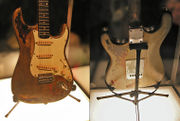

Gallagher was always associated with his well-worn sunburst 1961 Stratocaster (Serial Number 64351), which his brother Donal has officially retired. It was reputedly the first in Ireland, and was ordered from Fender by Jim Connolly, a showband member performing with The Irish Showband. Connolly ordered a cherry red Stratocaster through a music shop in Cork. When Fender shipped a sunburst Stratocaster instead, it went on sale as a second-hand instrument, which Gallagher bought for just shy of £100 at Crowley's Music Store on Cork's McCurtain Street. The guitar was extensively modified by Gallagher. The tuning pegs, for a start, are odd (5 Sperzel pegs and one Gotoh), and all of these have been found to be replacements. Secondly, it is thought that the nut has been replaced and interchanged a number of times. Thirdly, the scratchplate was changed during Gallagher's time with Taste. Another change was made regarding the pickups, of which none are original. The final modification was that of the wiring: Gallagher disconnected the bottom tone pot and rewired it so he had just a master tone control along with the master volume control. He also installed a 5-way selector switch in place of the vintage 3-way one. The most notable effect that years of touring have had is the almost complete removal of the guitar's original sunburst finish, due to Gallagher's rare blood type, which caused his sweat to be unusually acidic.[20] Although the Strat was left abandoned in a ditch, in the rain, for days after being stolen, this is not believed to have caused any of the effect. All of the wear is caused by playing, not misuse. It also had a period of time of having a replacement neck, with the original bowing due to the amount of moisture it absorbed during continuous touring. The neck was taken off the strat and left to settle, and was eventually reunited with the Strat after returning to its correct shape. Other quirks include a 'hump' in the scratch plate which moves the neck pickup closer to the neck on the bass side and a replacement of all of the pickups, though this replacement was due to damage rather than a perception of a tonal inadequacy. One final point of interest is that one of the clay double-dot inlays at the 12th fret fell out and was replaced with a plastic one, which is why it is whiter than the other clay inlays.
Amplifiers and effects

Gallagher used various makes and models of amplifiers during his career. In general, however, he preferred smaller 'combo' amplifiers to the larger, more powerful 'stacks' popular with rock and hard rock guitarists. To make up for the relative lack of power on stage, he would often link several different combo amps together.
When Gallagher was with Taste, he used a single Vox AC30 with a Dallas Rangemaster treble booster plugged into the 'normal' input. Examples of this sound can be heard on the Taste albums, as well as the album Live in Europe. Brian May, of the band Queen, has admitted in interviews that as a young man, he was inspired to use a Vox AC30 and treble booster setup after meeting Gallagher and asking him how he got his sound. The British company, Flynn Amps, now makes a Rory Gallagher Signature Hawk Treble Booster pedal based on Gallagher's original unit. Gallagher has also been known to use Ibanez Tube Screamers and various Boss effects.
In the early to mid 1970s, Gallagher began to use Fender amplifiers in conjunction with a Hawk booster, most notably a Bassman and a Twin, both 1950s vintage. An example of this sound can be heard on the Irish Tour '74 album. He also had a Fender Concert amplifier.
In the mid to late 1970s, when Gallagher was moving towards a hard rock sound, he experimented with Ampeg VT40 and VT22 amps. He also began using Marshall combos. During this period and beyond, Gallagher used different combinations of amps on stage to achieve more power and to blend the tonal characteristics of different amps including Orange amplification.
Death
From the late 1980s, he suffered increasingly poor health, yet he continued touring. By the time of his final performance on 10 January 1995 in the Netherlands, he was visibly sick. A liver transplant became necessary and was nearly successful, but just before being discharged from the hospital, an MRSA infection developed. His health quickly worsened and he died in London on 14 June 1995.[14] He was unmarried and had no children.
Gallagher was buried in St Oliver's Cemetery, on Model Farm Road just outside Ballincollig near Cork City, Ireland. His headstone is a replica of an award he received in 1972 for International Guitarist of The Year.
Legacy
In 2003, Wheels Within Wheels, a collection of acoustic tracks, was released posthumously by Gallagher's brother Donal Gallagher. Collaborators on this album included Bert Jansch, Martin Carthy, The Dubliners and Lonnie Donegan.
Many modern day musicians, including The Edge from U2, Slash of Velvet Revolver, Johnny Marr of the Smiths, Davy Knowles, Glenn Tipton of Judas Priest, Vivian Campbell of Def Leppard, Joe Bonamassa,[21] and Brian May of Queen,[22] cite Gallagher as an inspiration in their formative musical years.
There is an old story about Jimi Hendrix being asked by an interviewer after Woodstock what it was like to be the greatest guitar player in the world. Hendrix replied that he did not know. "Go ask Rory Gallagher".[23] Brian May, lead guitarist of Queen related how, when he was a child, he and a friend went up to Gallagher and asked, 'How do you get your sound Mr. Gallagher?' and he sits and tells us. So I owe Rory Gallagher my sound." [23] In 2010, Gallagher was ranked #42 on Gibson.com’s Top 50 Guitarists of All Time.[24]
Tributes
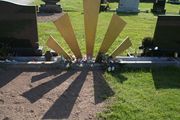
- On 25 October 1997 a tribute sculpture to Gallagher was unveiled in the newly renamed Rory Gallagher Place (formerly St. Paul's St. Square) in Cork. The sculptor was a childhood friend of Gallagher, Geraldine Creedon.[25] The two grew up together in the McCurtain Street area of the city. The band who played at the unveiling of the statue was the Dave McHugh band, who formed Ireland's first tribute to Gallagher, 'Aftertaste' in 1995.
- Comic book artist Timothy Truman is also a fan; with Grimjack #4: Legacy having a cover and story line utilizing Gallagher's image.
- There is a Rory Gallagher Exhibition located in Ballyshannon, Ireland, which contains a detailed history of his life and many items of memorabilia.
- There are a number of Gallagher tribute bands, many of whom perform at the annual Rory Gallagher International Tribute Festival in Ballyshannon.
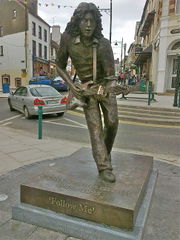
- A theatre in Ballyshannon has been renamed as the Rory Gallagher Theatre.
- There is a Rory Gallagher Corner at Meeting House Square in Temple Bar, Dublin, where a life-size bronze statue in the shape of his Stratocaster has been installed. Some of those who attended the unveiling include The Edge of U2 and the Lord Mayor of Dublin.
- In 2004 the Rory Gallagher Music Library was opened in Cork.[26]
- A street in Ris-Orangis, a commune in the southern suburbs of Paris, was renamed Rue Rory Gallagher.[27]
- The French town of Bédoin in Vaucluse at the base of Mont Ventoux has a street named after Gallagher in the old town, "Impasse Rory Gallagher"
- Irish musician John Spillane released a tribute song "A Song For Rory Gallagher" on his album Hey Dreamer
- French musician Dan Ar Braz released a tribute song "Gwerz Rory" on his album La Mémoire des Volets Blancs.
- English rock band The Wave Pictures recorded a song about Gallagher entitled "Live in Europe" on their 2004 album The Airplanes at Brescia.
- Flynn Amps manufacture a Rory Gallagher signature Hawk pedal cloned from Gallagher's 1970s pedal.[28]
- On 2 June 2010, a life-sized bronze statue of Gallagher was unveiled in the town centre of Ballyshannon.
- The Cork Institute of Technology has renamed the Theatre at its Bishopstown campus "The Rory Gallagher Theatre" Rory regularly performed at student functions.
Discography
- Rory Gallagher – 1971 (BPI: 100,000)
- Deuce – 1971 (BPI: 100,000)
- Blueprint – 1973 (BPI: 100,000)
- Tattoo – 1973 (BPI: 100,000) Rolling Stone review
- Against the Grain – 1975 (BPI: 100,000) Rolling Stone review
- Calling Card – 1976 (BPI: 60,000) Rolling Stone review
- Photo-Finish – 1978 (BPI: 60,000)
- Top Priority – 1979 (BPI: 60,000)
- Jinx – 1982 (BPI: 60,000)
- Defender – 1987 (BPI: 60,000)
- Fresh Evidence – 1990 (BPI: 60,000)[14]
- Wheels Within Wheels – 2003
See also
- List of people on stamps of Ireland
- List of blues musicians
References
- ↑ "Rory Gallagher's birth certificate". Flickr. http://www.flickr.com/photos/24788065@N02/4171904529. Retrieved 15 April 2010.
- ↑ "Rory Gallagher". Allmusic. http://www.allmusic.com/cg/amg.dll?p=amg&sql=11:gifexqe5ldke~T1. Retrieved 4 January 2010.
- ↑ Grossman, Stefan (March, 1978). "Rory Gallagher: Irish Guitar Star With Roots in American Blues and Rock". Magazine (Guitar Player magazine). http://sites.google.com/site/halloffamerorygallagher/gp2. Retrieved 28 April 2010.
- ↑ "Extract from Riding Shotgun biography — Prologue: Can't Believe It's True". Ridingshotgun.co.uk. http://www.ridingshotgun.co.uk/extract.html. Retrieved 11 March 2010.
- ↑ "The A-Z of Irish Music: G — Rory Gallagher Biography". Irish Connections. http://www.irishconnectionsmag.com/archives/v3i3/g.htm. Retrieved 11 March 2010.
- ↑ Stanton, Scott. (2003). The Tombstone Tourist: Musicians. Simon & Schuster. p. 319. ISBN 0-74346-330-7.
- ↑ 7.0 7.1 Minhinnette, Ray (July 21, 2005). "Rory Gallagher: A Previously Unpublished Interview". Modern Guitar Magazine. http://www.modernguitars.com/archives/000931.html. Retrieved 23 December 2009.
- ↑ Gallagher, Rory (1991). "Rory Gallagher 2nd Interview 1991 Audio". Radio interview. http://www.youtube.com/watch?v=gGoTiOl2J8M. Retrieved 4 April 2010.
- ↑ 9.0 9.1 Hunter, Stephen (4 January 2000). "Won't See His Like Again". This is a re-print of The Archive — Journal of the Northside Folklore Project, Issue 4, Jan 2000 pp.5-8 converted from PDF to HTML.. pp. 5–8. http://www.rory.de/cork/shunter/article.html. Retrieved 3 December 2009.
- ↑ "Rory Gallagher - 1976 interview, Part 1". WDR Studio Hall L Cologne, Grugahalle, Essen. Germany: The Complete Rockpalast Collection. 1976. http://www.youtube.com/watch?v=eSmi3SdApNc. Retrieved 4 December 2009.
- ↑ 11.0 11.1 Gallagher, Rory. "Gallagher biography". Official Website. http://www.rorygallagher.com/biography.htm. Retrieved 14 December 2009.
- ↑ 12.0 12.1 12.2 12.3 12.4 12.5 Roberts, David (1998). Guinness Rockopedia (1st ed.). London: Guinness Publishing Ltd.. pp. 168-169. ISBN 0-85112-072-5.
- ↑ 13.0 13.1 Buckley, Peter (ed.) (2003). The Rough Guide To Rock, pp. 409-10. Rough Guides Ltd. ISBN 1843531054.
- ↑ 14.0 14.1 14.2 14.3 14.4 14.5 Strong, Martin C. (2000). The Great Rock Discography (5th ed.). Edinburgh: Mojo Books. pp. 369-370. ISBN 1-84195-017-3.
- ↑ "Defender of the blues". Innerviews.org. http://www.innerviews.org/inner/rory.html. Retrieved 11 March 2010.
- ↑ McAvoy, Gerry; Chrisp (3 June 2005). Riding Shotgun: 35 Years on the Road with Rory Gallagher and Nine Below Zero. Pete. Kent: SPG Triumph. p. 82. ISBN 0955032016.
- ↑ "Rockpalast Night 23.-24.July 1977: Rory Gallagher 2.3.1948–14.6.1995". Rockpalast Archiv. September 1977. http://www.rockpalastarchiv.de/rn1_e.html. Retrieved 8 May 2009.
- ↑ Roberts, David (1998). Guinness Rockopedia (1st ed.). London: Guinness Publishing Ltd.. p. 242. ISBN 0-85112-072-5.
- ↑ Russell, Tony (1997). The Blues: From Robert Johnson to Robert Cray. Dubai: Carlton Books Limited. p. 67. ISBN 1-85868-255-X.
- ↑ "Rory's Strat". Biography piece. You Tube. http://www.youtube.com/watch?v=fxWi_FPa9Qw. Retrieved 14 December 2009.
- ↑ "An Interview with: Vivian Campbell". Mchicagomusicguide.com. http://www.chicagomusicguide.com/interview_campbell.htm. Retrieved 10 November 2008.
- ↑ "Rory Gallagher: A Previously Unpublished Interview". Modernguitars.com. http://www.modernguitars.com/archives/000931.html. Retrieved 24 October 2008.
- ↑ 23.0 23.1 Dvdverdict.com
- ↑ "Gibson.com Top 50 Guitarists of All Time – 50 to 41". Gibson.com. http://www.gibson.com/en-us/Lifestyle/Features/Top-50-Guitarists-524/. Retrieved 2010-06-03.
- ↑ "Rory Gallagher Tribute to be unveiled in Cork City Ireland". www.cork-guide.ie. http://www.cork-guide.ie/newsinfo/rory_gallagher.html. Retrieved 20 January 2010.
- ↑ "The Rory Gallagher Music Library". Cork City Council. October 2004. http://www.corkcity.ie/news/archivednews2004/mainbody,4266,en.html. Retrieved 18 January 2010.
- ↑ Auzias, Dominique; Labourdette, Jean-Paul (2008). Le Petit Futé Paris Spectacles: Edition 2008. Paris: Petit Futé. p. 37. ISBN 9782746919082. http://books.google.com/books?id=Tz4tNFC2TRwC&pg=PA37&dq=%22Rue+Rory+Gallagher%22+paris+Ris-Orangis&client=firefox-a&cd=1#v=onepage&q=%22Rue%20Rory%20Gallagher%22%20paris%20Ris-Orangis&f=false.
- ↑ "Flynn Amps — Rory Gallagher Hawk Booster". Flynn Amps. http://www.flynnamps.co.uk/hawk.html. Retrieved 18 January 2010.
- ↑ "Statue of rock icon Rory Gallagher unveiled". Irish Times. 2010-06-03. http://www.irishtimes.com/newspaper/ireland/2010/0603/1224271744791.html. Retrieved 2010-06-03.